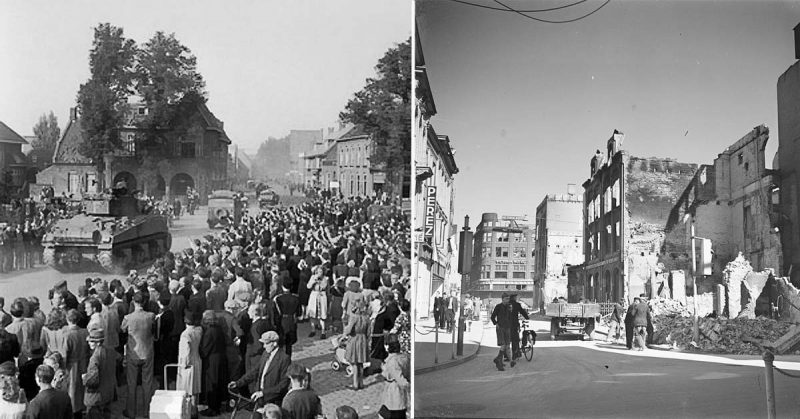What a pleasant occasion it must have been for Alan King, at 92 years of age, to once again meet up with the person whose life was saved – more than 70 years ago. The reunion took place in Holland, at the time of the commemoration of the Battle of Arnhem.
Toos Kockan, who is now 76, remembered Alan clearly and was so excited to see him that she gave him such a big hug. Alan, so very pleased to see her after all the years, felt that they were both quite emotional. Alan was particularly affected by the memories this meeting evoked, for a while he was delighted with the thought that Toos as well as her family had survived, his thoughts also strayed to the huge number of people who did not.
Alan was particularly affected by the memories this meeting evoked, for a while he was delighted with the thought that Toos as well as her family had survived, his thoughts also strayed to the huge number of people who did not.
Alan was 20 years old when he took part in the October 1944 attack against the Nazis, in the Dutch city of ‘s-Hertogenbosch during the battle designated ‘Operation Pheasant.’ He was a wireless operator in the East Riding Yeomanry and was in a Sherman tank at the time.
During the battle – which raged on for over three days – his Sherman tank regiment came up against the German Panzers and he remembers that particular day, in which Toos’ life was saved, very clearly. He was in his tank when they were involved in a fierce battle, with shells bursting everywhere, while roof tiles and bits of timber were flying all over the place. Suddenly, a terrified family of five rounded the corner with shells exploding about them as they fled their shelled house.
Since the visibility from a Sherman tank was very poor, each person merely seeing through a small slit, the driver of Alan’s tank began reversing the 30-ton tank, not knowing that Toos and her mother were directly behind it. The tank squadron leader yelled at the family – the heavily pregnant mother struggling along, trying to help Toos, and the father struggling with the pushchair – to run for it. Alan heard the wireless operator in the tank behind them yelling for them to ‘halt, halt, halt’.
Alan realised that the family had inadvertently run behind the reversing tank and managed to call to his driver to halt! Thankfully the driver managed to stop – just in time. The shocked family was helped to safety, for two infantrymen picked up Toos and her mum who were directly behind the tank and would undoubtedly have been run over, while foot soldiers helped the father and the other two children. They were all helped to get to the safety of a shelter. The three days of this ‘s-Hertogenbosch battle resulted in the deaths of 253 civilians, injured 2,100 and destroyed a total of 722 buildings.
Alan was one of 156,000 Allied troops who, on D-Day, June the 6th of 1944, had landed on the beaches of Normandy. He arrived on Sword Beach at dawn, with his tank regiment, and clearly remembers the wild and stormy seas which greatly hindered their landings. In spite of the terrible casualties of that day, he survived to continue the fight, and his tank regiment was deployed in numerous attacks aimed at containing German Panzer units. One of them, during July, was that of ‘Operation Goodwood’, where once again he experienced the loss of many of their men and tanks, having begun the operation with 600 tanks and ending up with only 100.
Thus, by October, the time of the battle, for ‘s-Hertogenbosch, Alan was already an ‘old hand’ at the war scene, for after taking part in the D- Day battles, his tank regiment had continued fighting its way across Europe. He tells us that he was extraordinarily fortunate, for he had narrowly escaped death five times, having had his tank ‘knocked out’ each of those times. Not surprisingly – he still clearly remembers the battles he fought in during the war.
After the war, Alan King returned to his home in Suffolk, and worked as a steam engineer. He was later awarded the prestigious Legion d’Honneur medal by France for his role in the D-Day landings. Toos also survived the war and later married and had two children, Mirror reported.
Today, at the marvellous age of 92 and a Great-grandfather of six, when Alan looks at the photo he has of little Toos standing by the tank, he is reminded of his own daughters when they were little, and mentions just how grateful he is that his children did not have to “grow up in the middle of a war.”
How wonderful it would be if that could be true for all this world’s children.
